TV Station RKK
Tech Innovators in Japan ① The Endless Potential of Pulsed Power ② Modern Decor with an Ancient Story
DC292244![]()
世界一の九州が始まる! ①一瞬で未来を変える!?驚異の稲妻パルスパワー ②里山発!進撃のインテリアブランド [RKK]
![]()
![]()
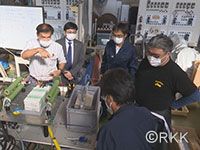
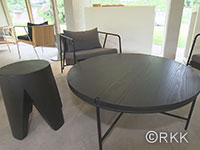
|Length : 21min |Year : 2022 |
①The Endless Potential of Pulsed Power
A new insecticidal device that uses an enormously powerful, lightning-fast pulse of electricity to kill off Anisakis, a parasite that causes food poisoning, is garnering attention around the world. The device wields an incredible kind of energy called pulsed power. A variety of industries can already see its promise, and pulsed power is being hailed as a savior of the next generation. Associate Professor Takao Namihira of Kumamoto University is persevering in his research in hopes of finding everyday applications for this energy, which was originally developed for military use.
②Modern Décor with an Ancient Story
Furniture made from Oguni cedar, a special type of Japanese cedar found in Minamioguni Town in the Aso region of Kumamoto Prefecture, has become a hit not only in Japan, but across the globe. The company responsible is Foreque, a local brand with only five employees. When their sleek designs grabbed the attention of international media outlets, they were flooded with orders from Japanese and foreign customers alike. Company president Syunsuke Anai recalls that when he first started the company, every furniture maker he spoke to wrote off Oguni cedar as an unsuitable material for furniture. Despite their pessimism, Anai held onto his strong desire to create one-of-a-kind products and protect the forest he loves.
Tech Innovators in Japan~①Magic Paint that Shields the Streets ②Keeping Tradition Alive with Kaya from Aso
DC292143![]()
世界一の九州が始まる!①道を守る水性ペイント②伝統文化つなぐ阿蘇のカヤ [RKK]
![]()
![]()


|Length : 24min |Year : 2021 |
1. Japan's transport infrastructure, in particular roads and bridges, was mainly built in the country's rapid economic growth decades. However, problems of infrastructure aging and scenery maintenance are causes of concern for citizens and civil authorities. Kumamoto construction company Amaken Tech has stepped up to help resolve these problems with a revolutionary new paint. This water-based paint is non-toxic and scentless, yet is strong against abrasion. It’s a revolutionary new option for the road construction industry, which still uses enormous amounts of long-lasting oil-based paint. In this half of the program, we investigate the traits and technology of this paint, which is finding its way onto roads all through the country.
2. Constructors of traditional Japanese buildings have a big problem: where do they get the kaya grass to replace kayabuki thatched rooves? Kaya growers are decreasing in number, as are the grasslands where one can harvest kaya. Meanwhile, in Aso, volunteers are gathered each year to burn down kaya grass to maintain farmland.
Yasutaka Yamamoto from the Aso-based GS Corporation has started a new business, purchasing kaya grass harvested before burns, to be sold to kayabuki craftsmen in Kyoto. It’s helping to provide income to farmers in the off-season, and motivation to protect Aso’s grassland. In this half of the program, we talk with Yamamoto about his work to protect traditional architecture, and meet the people of Aso helping to gather and maintain kaya grass.
Tech Innovators in Japan~ ①Visualizing Heart Disease ②Miracle Meat to Save the World~
DC292041![]()
世界一の九州が始まる! ①心音が“見える”!超聴診器 ②地球を救うミラクルミート [RKK]
![]()
![]()
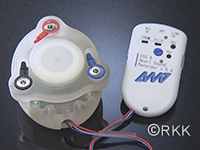
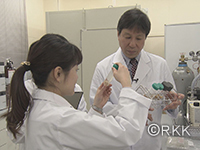
|Length : 24min |Year : 2020 |
① President of the medical startup AMI Co., Ltd., cardiovascular disease specialist Shinpei Ogawa has developed a stethoscope that allows doctors to see heartbeats.
Until now, stethoscopes have only provided the sound of heartbeats; by turning them into graphic data, it allows for early detection of heart disease and assists doctors with diagnoses. There are even plans to use it in telemedicine, as performing stethoscopies via the internet can benefit areas with a shortage of doctors. Could this device be a breakthrough for the countries’ ageing population, as well as areas short on doctors?
② As the world’s population increases, so do fears of a future protein shortage. For that reason, DAIZ, a company located in Kumamoto City, Japan, has developed a “miracle meat” made solely from soy beans. Koji Ochiai, DAIZ’s Head of Research and Development, was interested in the fact that germinating soy beans share similar properties with animal meat. And by altering their sprouting conditions, he was able to produce “meat” that closely resembled the taste of beef, pork, chicken, and more. Since then, he has continued to develop this miracle meat in the hopes that it may one day save the world.
Tech Innovators in Japan~①Glass Artisans Reaching for New Heights ②Globalizing Traditional Japanese Interiors~
DC291940![]()
世界一の九州が始まる! ①ガラスの業師~頂点目指す町工場~ ②和室を世界へ [RKK]
![]()
![]()
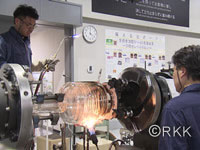
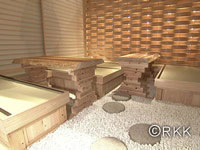
|Length : 25 |Year : 2019 |
①Glass Artisans Reaching for New Heights
In June 2018, Germany hosted an international chemical industry trade show. There, the most attention-grabbing device was one with a 200-liter flask—the largest in the world. The company behind this large-capacity flask is Asahi Glassplant Inc. Founded as a small factory approximately 70 years ago, it’s since grown to produce various unique products. Working with heated glass, the successes or failures of their artisans are decided in one nerve-racking instant. The company continuously surmounts seemingly-impossible projects thanks to the founder’s motto: never turn down customer requests. Asahi Glassplant now uses manual manufacturing processes unique to them thanks to their highly-skilled glass artisans.
②Globalizing Traditional Japanese Interiors
A new project to export traditional Japanese interiors is underway. Targeting Asia, this project led by Teppei Yamaguchi (35) aims to increase business and expand the market for Kumamoto-grown wood and Japanese architecture. Joining them is Mitsunori Nagahama (65), a master of traditional carpentry, but opportunities to demonstrate his expertise in modern home construction grow scarce. In order to preserve traditional Japanese techniques, they concluded it was necessary to showcase its beauty overseas. While researching and exhibiting in Asia, a request to build a model room came from Thailand. But what do people in Asia look for in traditional Japanese interiors? These craftsmen take on a new challenge to show the world the appeal of Japanese interiors through timber and traditional techniques.
Tech Innovators in Japan~①Making Papers from Waste Materials ②Packing Revolution Using Unique Scales~
DC291836![]()
世界一の九州が始まる! ① 棄てられるものの輝き ②小分け革命!~はかり知れない計量器~ [RKK]
![]()
![]()
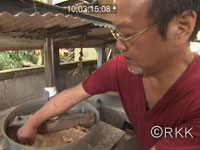

|Length : 24 |Year : 2018 |
① The "Haguregumo Workshop” in Minamata City, Kumamoto Prefecture, is a paper-making workshop started by Junpei Kanazashi thirty years ago. They use traditional materials like mulberry bark as well as banana leaves, onion skin, even worn-out jeans to make paper. Junpei’s wife Hiroko raises her own cotton and flowers to make colored cloth. According to Junpei, Japan is unique in how its art was developed through things to use in one’s life, as opposed to things to view and appreciate like in Europe. Japan was once a society of recycling, living in harmony with nature. Junpei seeks to keep that wisdom alive through his work, and to show it to the world.
② A new measuring scale is revolutionizing Japan’s vegetable sorting industry. The “Table Combi” developed by OK Planning (based in Kumamoto City) is a measuring device that notifies workers of an appropriate produce combination the moment its scales have found one. Company president Mitsuru Hatae departed his desk job in his forties and started a company with the goal of making produce packaging as easy on the workers as he could. To make measuring scales makers of produce really need, he spends his days bouncing back and forth between his office and farmer worksites. It’s been three years since they started development, and now this venture business of five employees is aiming for national and international business with their unique strategies.
- 1
- 2














